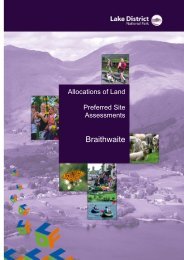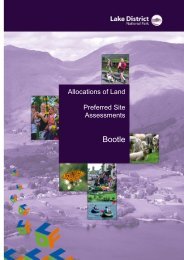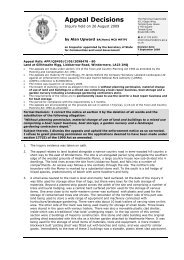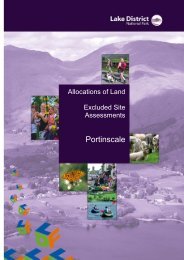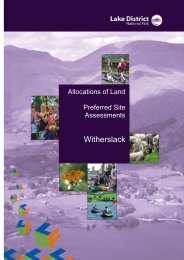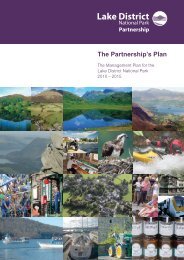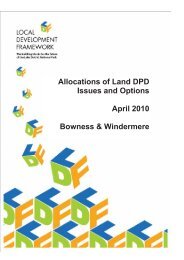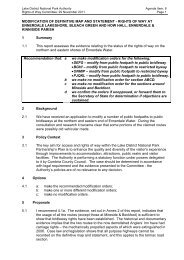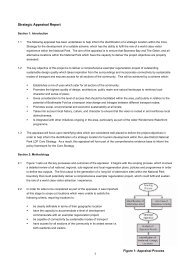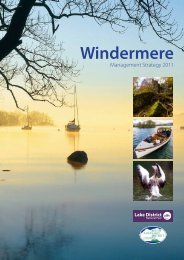Booklet pages 13 - 15 (PDF)
Booklet pages 13 - 15 (PDF)
Booklet pages 13 - 15 (PDF)
You also want an ePaper? Increase the reach of your titles
YUMPU automatically turns print PDFs into web optimized ePapers that Google loves.
IV<br />
MEET THE LOCAL TRIBE<br />
Introducing the Brigantes<br />
This session aims to develop understanding of the Brigantes and explore their lives in some detail.<br />
In subsequent sessions this understanding will be used to contrast the Brigantes with the Romans.<br />
CURRICULUM LINKS: HISTORY 2A, 2B, 4A, 4B, 5A, 5C, 6, 7, 8A, 9<br />
ART & DESIGN 5A CITIZENSHIP 4B ENGLISH 1C, 2C, 4A<br />
OVERVIEW<br />
STARTER<br />
whole class<br />
ROLE PLAY AND<br />
INFORMATION<br />
GATHERING<br />
small groups<br />
individual<br />
AN INTERVIEW<br />
WITH<br />
CARTIMANDUA<br />
whole class<br />
PLENARY<br />
whole class<br />
ACTIVITY<br />
DETAILS<br />
Brief idea gathering<br />
Pupils volunteer all the facts they can<br />
remember about the Brigantes from<br />
Session III. They then suggest<br />
questions about the Brigantes that<br />
they would like to have answered.<br />
Learning about the Brigantes<br />
Children from half the class are<br />
each given role-play cards describing<br />
a Brigantian character and his or her<br />
life. Children from the other half of<br />
the class interview the ‘Brigantes’.<br />
All pupils complete a worksheet,<br />
recording their findings using words<br />
and images.<br />
The tale of Cartimandua<br />
Pupils hear the story of<br />
Cartimandua and discuss what she<br />
might have been like. They then<br />
imagine that they are Newsround<br />
reporters preparing to interview her.<br />
They draw a picture showing how<br />
they imagine she looks, and write<br />
down the questions they would like<br />
to ask her.<br />
Reviewing starter questions<br />
Pupils review their starter questions.<br />
Have they been answered? Were<br />
they good questions?<br />
LEARNING<br />
INTENTIONS<br />
• To revisit previous learning<br />
and use this as a<br />
springboard to generate<br />
interest in learning more<br />
about the Brigantes.<br />
• To learn about several<br />
aspects of Brigantian<br />
lives.<br />
• To develop the skills of<br />
empathy and role play.<br />
• To develop the ability to<br />
identify and ask good<br />
questions, to absorb<br />
information, and to provide<br />
detailed answers.<br />
• To bring the Brigantes to<br />
life through a true story.<br />
• To develop skills of<br />
curiosity and imagination.<br />
• To think about what makes<br />
a good question.<br />
• To make explicit the<br />
learning that has taken place.<br />
RESOURCES<br />
• Role-play cards<br />
(CD Resource 32)<br />
• Worksheets (CD<br />
Resources 33 & 34)<br />
• Reference images<br />
of Celts and Celtic<br />
village (CD Resources<br />
35-38)<br />
• The Tale of<br />
Cartimandua<br />
(CD Resource 39)<br />
• Reporter worksheet<br />
(CD Resources 40<br />
& 41)<br />
THE ROMANS IN THE LAKE DISTRICT <strong>13</strong>
BACKGROUND INFORMATION<br />
THE CELTIC WAY OF LIFE<br />
The Brigantes were a Celtic tribe of native Britons who lived in the north of England. The best information<br />
about the Brigantes comes from Roman writers. The Brigantes transmitted information orally and used organic<br />
materials, and therefore left little physical or written evidence.<br />
The Brigantes believed in a number of gods associated with nature and the seasons, and the tribe was named<br />
after the Celtic goddess of spring, Brigit. They are thought to have been the most powerful tribe that the<br />
Romans encountered in Britain. Their ruler at the time of the invasion was Queen Cartimandua.<br />
The Brigantes lived in clans and extended families, often all together in the same house. They built roundhouses<br />
with low stone walls and a thatched roof.<br />
Men and women had different roles but were given equal status. The men often had to fight to protect their<br />
land from other Celts and eventually the Romans. Women’s roles included ensuring everyone was fed, spinning<br />
wool and making clothes. Children would generally help out with their mothers’ chores, tending to the animals,<br />
helping to grind grain and so on. They did not go to school!<br />
The Brigantes were pastoral farmers. Men would hunt and fish, and the women made cheese and bread. They<br />
also foraged for wild foods like nuts and berries. In autumn some of the farm animals were slaughtered. The<br />
meat was hung up inside the roundhouses to smoke and preserve, providing a supply for the winter. A kind of<br />
beer was made from barley. This beer was more like a thick alcoholic porridge than a drink. Drinking beer was<br />
much safer than drinking water, as the brewing process got rid of any germs.<br />
WHAT DID THE CELTS LOOK LIKE? (CD RESOURCES 35 & 36)<br />
The Celts wore very practical clothes made from sheep’s wool, which is naturally waterproof because it contains<br />
lanolin, an oil released from the sheep’s skin. They used natural dyes and liked very bright colours and checked<br />
and tartan patterns.<br />
The women wore a long pale dress beneath a more colourful tunic, with a leather belt to keep the dress and<br />
tunic from dragging on the floor. A pouch on the belt was used to hold precious things. On colder days the<br />
women wore a heavy shawl, pinned at the front with a brooch. They wore leather shoes, made to measure for<br />
each person. The shoes were made of a single piece of leather with holes in the sides for a leather thong to lace<br />
them up. In the winter they lined the shoes with straw for warmth. Women’s hair was worn tied up in braids or<br />
plaits which reduced the need for washing.<br />
The men wore an undergarment beneath their long shirts, and trousers in the colder months. For extra warmth<br />
they wore a cloak, again fastened at the front with a brooch. Men’s shoes were very like those of the women.<br />
Celtic men are said to have had big moustaches. They whitened their hair with lime, a chalk-like powder mixed<br />
with water. For battles they painted their bodies with a blue dye made from the woad plant, to scare off their<br />
enemies.<br />
WHAT WAS A CELTIC VILLAGE LIKE? (CD RESOURCES 37 & 38)<br />
The walls of the roundhouses were made of stones, fitted together like the stones in a dry stone wall. The<br />
thatched roofs did not have chimney holes. Instead the fire was positioned in the centre of the house, under the<br />
tallest part of the roof. The smoke gathered in the roof space and slowly seeped out through the thatch. Even<br />
though smoke could get out, the thatched roofs were waterproof and rain could not get in. The houses were<br />
built by master craftsmen and if taken care of, could have stood for at least 200 years. The stone walls between<br />
the houses were to prevent villagers’ animals from wandering off.<br />
14 THE ROMANS IN THE LAKE DISTRICT
ACTIVITY GUIDELINES<br />
ROLE PLAY<br />
In Session IV, half the class take on the role of<br />
Brigantians, with the guidance of role-play cards (CD<br />
Resource 32). In Session V the other half of the class<br />
will take on the role of Romans. Those who are not<br />
role-playing ask questions to find out about the others’<br />
lives.<br />
To give children more confidence in answering the<br />
questions they can be put in groups of ‘men’, ‘women’<br />
and ‘children’.<br />
Alternatively you could ask children from the same<br />
family to sit together. This will give the role-players<br />
the chance to hear about a wider range of characters<br />
and allow questioners to stay with one group rather<br />
than wandering around the room.<br />
In Session IV, give each group a copy of the annotated<br />
images of people and houses (CD Resources 36 &<br />
38). This will help them understand more about their<br />
characters, and to visualise their clothes and homes. It<br />
will also provide some of the information needed by<br />
the other pupils filling in their worksheets.<br />
You can either ask the questioners to fill in their<br />
worksheets as they go along and the role-players to fill<br />
out theirs at a later session, or you can ask everyone to<br />
fill out their worksheets at the same time when the<br />
question and answer session is over.<br />
AN INTERVIEW WITH CARTIMANDUA<br />
Read the story (below, and CD Resource 39) to the<br />
class. Ask children for their ideas about what Queen<br />
Cartimandua may have been like.<br />
Working alone, the children then devise questions they<br />
would ask Queen Cartimandua as though preparing<br />
an interview for Newsround (CD Resources 40 & 41).<br />
THE TALE OF CARTIMANDUA<br />
Cartimandua loved being queen of the Brigantes. She enjoyed the feeling of having power<br />
over her tribe, and fiercely wanted to hang on to it all.<br />
When rumours reached her of the Romans, and their battles with tribes in the south, she<br />
was troubled. In all the tales she heard the Romans always won. Traders and spies told her of<br />
the rich life lived by these mighty Roman warriors, with their grand stone buildings and delicate<br />
pottery and glass. Afraid that she was going to lose everything, Cartimandua prayed to the<br />
gods for a sign, showing her what to do.<br />
At this time King Caractacus ruled a tribe living in the west. His tribe fought bravely against<br />
the Romans but were defeated and the king and his family fled in fear of their lives. They ran<br />
north to Cartimandua and begged for her protection. She looked at the king, his wife and<br />
children, and decided that this was her sign from the gods. She took them in and offered them<br />
rest and safety, but secretly sent messages to the Roman Emperor Claudius offering up her<br />
guests as prisoners. King Caractacus and his family were betrayed and taken by the Romans.<br />
The Romans gave Cartimandua great rewards – gifts of beautiful jewellery, pottery and glass.<br />
Cartimandua knew the Romans would not attack her now that she was their friend, and she<br />
began to dream of an even better, richer life. She became bored with her husband Venutius<br />
who had become lazy and spent all his time hunting and feasting. She longed for a younger,<br />
braver, more handsome man and her eye fell on Vellocatus, who was her husband’s armourbearer.<br />
Cartimandua divorced her husband and married young Vellocatus instead.<br />
The tribe was furious with their middle-aged queen for behaving like this – marrying a<br />
teenager! – and Venutius swore that he would have his revenge. He gathered together some<br />
angry tribespeople and attacked Cartimandua. Fearing for her safety she sent messages to the<br />
Romans, who tried several times before they were finally able to rescue her.<br />
Nobody knows what happened to Cartimandua and Venutius after this. The Romans did<br />
become the rulers of the Brigantes. Over time everyone became used to the new situation and<br />
lived in peace. Whether the Queen got to live the life of luxury she dreamed of…who can say?<br />
THE ROMANS IN THE LAKE DISTRICT <strong>15</strong>



